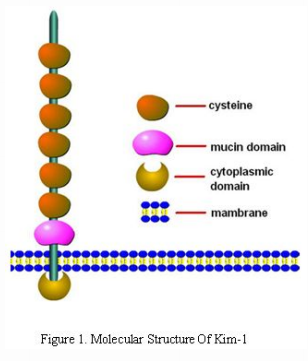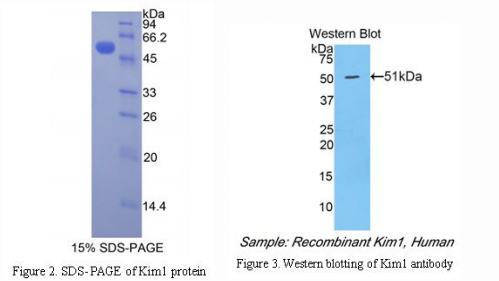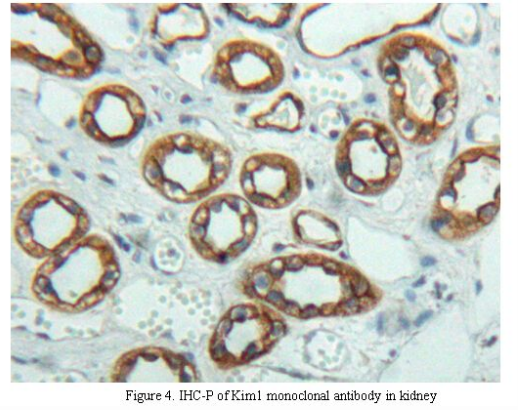Kidney injury molecule -1 (KIM-1) - an important indicator of early kidney disease
Recently, the global incidence of nephropathy showed an increasing trend. Besides cancer and heart disease, as the third largest "killer", it is very difficult for clinical physicians to make the diagnosis of early renal disease. This is mainly due to patients with early renal disease have no obvious symptoms, which is easy to delay treatment. So far, the indicators to determine kidney damage includes urine osmolality, osmotic pressure, serum creatinine, urea nitrogen, creatinine clearance rate and so on, but when these indicators increased, in most cases, serious kidney damage or irreversible damage has already appeared. Therefore, looking for new indicators for early detection of kidney disease has become one of the hotspots in the medical field.

Currently, many researchers use activity of N-Acetyl-Alpha-DGlucosaminidase (NAGLU) as an early indicator of renal damage, but the latest cutting-edge research shows that in addition to NAGLU activity, kidney injury molecule-1 (Kim-1) also can characterize the injury and recovery process of nephropathy in a very rapid, sensitive and specific manner, which provides another important indicator for early renal injury. This detection combined with NAGLU activity can monitor acute kidney injury with high accuracy, specificity, and low false-positive rate, etc. Thus it has broad application prospects in clinical practice. The structural features of Kim-1 and related testing products are as follows.
Kidney injury molecule-1 is a novel type I transmembrane glycoprotein that belongs to the immunoglobulin superfamily. This protein is encoded by hepatitis A virus receptor -1 (HAVcr-1) and the structure is shown in Figure 1, the extra-cellular region is composed of a mucin domain links to immunoglobulin-like domain that includes six cysteine residues. Kim-1 has a very low expression in kidney tissue in healthy people, while its expression enhances significantly within a few hours after kidney damage. In situ hybridization and immunohistochemical analysis show that Kim-1 is primarily expressed in dedifferentiated renal proximal tubular epithelial cells which have been regenerated after injury, especially in the outer medulla rich region S3 segment of the proximal tubule.
In order to make it easier for researchers to study the function of Kim-1 and detect Kim-1 in vitro and in vivo more accurately and rapidly, Cloud-Clone Corp. successfully constructed the extracellular domain of kidney injury molecule-1 (Ser21 ~ Ala240) into expression vector, and then expressed the recombinant protein of Kim-1 (RPA785Hu01) (Figure 2).
Then, Cloud-Clone Corp. use this recombinant protein to immunize animals, and then the anti-serum is purified by affinity chromatography system to obtain polyclonal antibody specific to human kidney injury molecule -1 (Kim-1). This antibody has high purity (PAA785Hu01), and it is found that this antibody can specifically bind Kim-1 protein through methods such as Western Blot testing (Figure 3). Additionally, Cloud-Clone Corp. has successfully developed the ELISA kit for human Kim-1 (SEA785Hu and SCA785Hu). The kits can detect the content of Kim-1 quantitatively in a variety of human samples, including human tissue, urine, cell culture supernatant, or other biological fluids. In addition, Cloud-Clone Corp. also developed ELISA Kit for N-Acetyl Alpha-D-Glucosaminidase (SED161Hu), and laboratory personnel would conduct a simultaneous detection of Kim-1 and NAG enzyme in clinical samples, so that making a more accurate analysis for patient's condition.

Furthermore, Cloud-Clone Corp. developed Monoclonal Antibody to Kidney Injury Molecule 1 (MAA785Hu22), and the result of IHC test displays a high-level expression of Kim-1 in the renal tissue of nephritis patients, strong signals are shown in the membrane of renal tubular epithelial cell, as shown in Figure 4. According to the demand of customers, Cloud-Clone Corp. labeled antibodies with FITC and biotin to obtain antibodies of PAA785Hu81 and PAA785Hu71. The conjugated monoclonal antibody not only can recognizes Kim-1 specifically, but also can be more convenient for an in vivo detection of Kim-1.

In addition to these products, Cloud-Clone Corp. also successfully developed Kim-1 related products for mice and rats, as shown in Table 1, these products provide a very sound technical platform for laboratory personnel.
Table 1. Information sheet of other Kim-1related products
| Name of product | Product No. | Organism species |
| Recombinant Kidney Injury Molecule 1 (Kim1) | RPA785Mu01; RPA785Mu02 | Mus musculus (Mouse) |
| Polyclonal Antibody to Kidney Injury Molecule 1 (Kim1) | PAA785Mu01; PAA785Mu02 | Mus musculus (Mouse) |
| FITC-Linked Antibody to Kidney Injury Molecule 1 (Kim1) | PAA785Mu81 | Mus musculus (Mouse) |
| Biotin-Linked Antibody to Kidney Injury Molecule 1 (Kim1) | PAA785Mu71 | Mus musculus (Mouse) |
| ELISA Kit for Kidney Injury Molecule 1 (Kim1) | SEA785Mu | Mus musculus (Mouse) |
| CLIA Kit for Kidney Injury Molecule 1 (Kim1) | SCA785Mu | Mus musculus(Mouse) |
| Recombinant Kidney Injury Molecule 1 (Kim1) | RPA785Ra01 | Rattus norvegicus (Rat) |
| Polyclonal Antibody to Kidney Injury Molecule 1 (Kim1) | PAA785Ra01 | Rattus norvegicus (Rat) |
| Monoclonal Antibody to Kidney Injury Molecule 1 (Kim1) | MAA785Ra21 | Rattus norvegicus(Rat) |
| ELISA Kit for Kidney Injury Molecule 1 (Kim1) | SEA785Ra | Rattus norvegicus(Rat) |
| CLIA Kit for Kidney Injury Molecule 1 (Kim1) | SCA785Ra | Rattus norvegicus(Rat) |
More related products, please visit : www.cloud-clone.us.
